 Afrikaans
Afrikaans  Albanian
Albanian  Amharic
Amharic  Arabic
Arabic  Armenian
Armenian  Azerbaijani
Azerbaijani  Basque
Basque  Belarusian
Belarusian  Bengali
Bengali  Bosnian
Bosnian  Bulgarian
Bulgarian  Catalan
Catalan  Cebuano
Cebuano  Corsican
Corsican  Croatian
Croatian  Czech
Czech  Danish
Danish  Dutch
Dutch  English
English  Esperanto
Esperanto  Estonian
Estonian  Finnish
Finnish  French
French  Frisian
Frisian  Galician
Galician  Georgian
Georgian  German
German  Greek
Greek  Gujarati
Gujarati  Haitian Creole
Haitian Creole  hausa
hausa  hawaiian
hawaiian  Hebrew
Hebrew  Hindi
Hindi  Miao
Miao  Hungarian
Hungarian  Icelandic
Icelandic  igbo
igbo  Indonesian
Indonesian  irish
irish  Italian
Italian  Japanese
Japanese  Javanese
Javanese  Kannada
Kannada  kazakh
kazakh  Khmer
Khmer  Rwandese
Rwandese  Korean
Korean  Kurdish
Kurdish  Kyrgyz
Kyrgyz  Lao
Lao  Latin
Latin  Latvian
Latvian  Lithuanian
Lithuanian  Luxembourgish
Luxembourgish  Macedonian
Macedonian  Malgashi
Malgashi  Malay
Malay  Malayalam
Malayalam  Maltese
Maltese  Maori
Maori  Marathi
Marathi  Mongolian
Mongolian  Myanmar
Myanmar  Nepali
Nepali  Norwegian
Norwegian  Norwegian
Norwegian  Occitan
Occitan  Pashto
Pashto  Persian
Persian  Polish
Polish  Portuguese
Portuguese  Punjabi
Punjabi  Romanian
Romanian  Russian
Russian  Samoan
Samoan  Scottish Gaelic
Scottish Gaelic  Serbian
Serbian  Sesotho
Sesotho  Shona
Shona  Sindhi
Sindhi  Sinhala
Sinhala  Slovak
Slovak  Slovenian
Slovenian  Somali
Somali  Spanish
Spanish  Sundanese
Sundanese  Swahili
Swahili  Swedish
Swedish  Tagalog
Tagalog  Tajik
Tajik  Tamil
Tamil  Tatar
Tatar  Telugu
Telugu  Thai
Thai  Turkish
Turkish  Turkmen
Turkmen  Ukrainian
Ukrainian  Urdu
Urdu  Uighur
Uighur  Uzbek
Uzbek  Vietnamese
Vietnamese  Welsh
Welsh  Bantu
Bantu  Yiddish
Yiddish  Yoruba
Yoruba  Zulu
Zulu Feb . 18, 2025 10:07
Back to list
Slagging Pulley(Heavy Duty)
In the industrial realm, the significance of drum pulley lagging cannot be overstated. Often overlooked by those outside the sector, this innovative solution plays a pivotal role in enhancing conveyor system efficiencies across various industries. By providing friction necessary for effective power transmission and protecting the pulley and belt from wear, drum pulley lagging is an essential component for the longevity and performance of conveyor systems.
Renowned manufacturers of drum pulley lagging understand the intricacies involved in crafting lagging solutions tailored to diverse industrial needs. Their expertise provides invaluable guidance, enabling businesses to select the right type of lagging for their specific conveyor systems. By working closely with these manufacturers, industries can leverage cutting-edge technological advancements and ensure that their conveyors operate at peak efficiency. Furthermore, drum pulley lagging contributes to safer operating conditions by reducing the risk of belt slippage, which can otherwise be a major hazard. By maintaining steady and controlled movement of the conveyor belt, it minimizes the potential for accidents, promoting a safer work environment for employees. Trust in the product is bolstered by the credible reputation of manufacturers offering robust warranties and after-sales service. Such assurances not only reflect confidence in the product’s quality but also enhance trustworthiness among clients who rely on these solutions for critical operations. In conclusion, drum pulley lagging is an indispensable asset for any industry reliant on conveyor belt systems. Its contribution to enhanced performance, cost-effectiveness, and safety underscores its value. By diligently selecting, installing, and maintaining this crucial component, industries can not only elevate their operational efficiency but also ensure a more sustainable and productive future.


Renowned manufacturers of drum pulley lagging understand the intricacies involved in crafting lagging solutions tailored to diverse industrial needs. Their expertise provides invaluable guidance, enabling businesses to select the right type of lagging for their specific conveyor systems. By working closely with these manufacturers, industries can leverage cutting-edge technological advancements and ensure that their conveyors operate at peak efficiency. Furthermore, drum pulley lagging contributes to safer operating conditions by reducing the risk of belt slippage, which can otherwise be a major hazard. By maintaining steady and controlled movement of the conveyor belt, it minimizes the potential for accidents, promoting a safer work environment for employees. Trust in the product is bolstered by the credible reputation of manufacturers offering robust warranties and after-sales service. Such assurances not only reflect confidence in the product’s quality but also enhance trustworthiness among clients who rely on these solutions for critical operations. In conclusion, drum pulley lagging is an indispensable asset for any industry reliant on conveyor belt systems. Its contribution to enhanced performance, cost-effectiveness, and safety underscores its value. By diligently selecting, installing, and maintaining this crucial component, industries can not only elevate their operational efficiency but also ensure a more sustainable and productive future.
Latest news
-
Revolutionizing Conveyor Reliability with Advanced Rubber Lagging PulleysNewsJul.22,2025
-
Powering Precision and Durability with Expert Manufacturers of Conveyor ComponentsNewsJul.22,2025
-
Optimizing Conveyor Systems with Advanced Conveyor AccessoriesNewsJul.22,2025
-
Maximize Conveyor Efficiency with Quality Conveyor Idler PulleysNewsJul.22,2025
-
Future-Proof Your Conveyor System with High-Performance Polyurethane RollerNewsJul.22,2025
-
Driving Efficiency Forward with Quality Idlers and RollersNewsJul.22,2025
OUR PRODUCTS





























